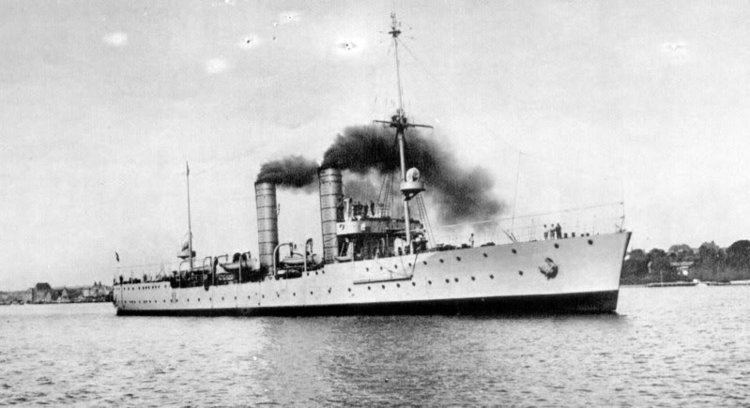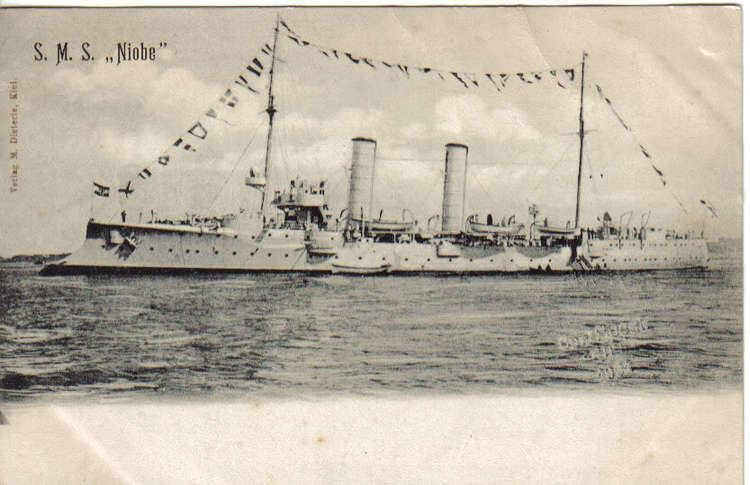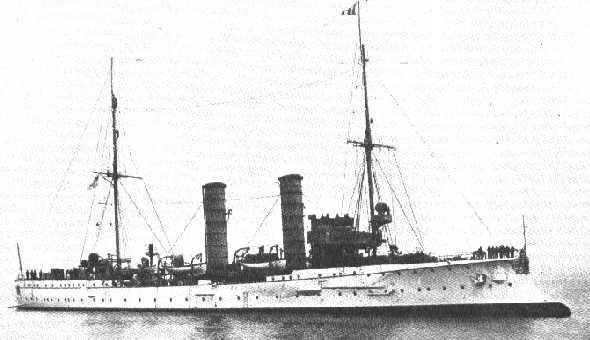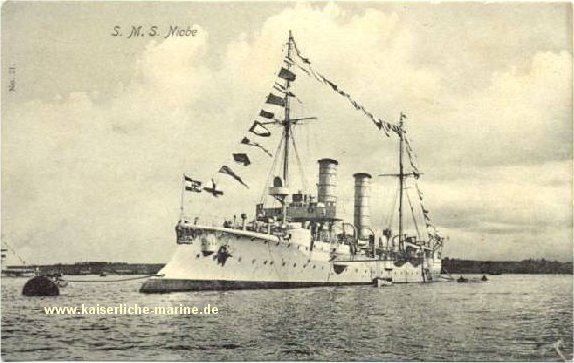Commissioned 25 June 1900 Name Dalmacija Construction started 1898 Length 105 m Beam 12 m | Laid down 1898 Out of service Sold to Yugoslavia Acquired 26 June 1925 Launched 18 July 1899 Weight 2,963 tons | |
 | ||
SMS Niobe ("His Majesty's Ship Niobe") was the second member of the ten-ship Gazelle class of light cruisers built by the Imperial German Navy. She was built by the AG Weser shipyard in Bremen, laid down in 1898, launched in July 1899, and commissioned into the High Seas Fleet in June 1900. She was named after Niobe, a figure from Greek mythology. Armed with a main battery of ten 10.5 cm (4.1 in) guns and two 45 cm (18 in) torpedo tubes, Niobe was capable of a top speed of 21.5 knots (39.8 km/h; 24.7 mph). The ship had a long career, serving in all three German navies, along with the Yugoslav and Italian fleets over the span of over 40 years in service.
Contents

Niobe served in both home and overseas waters in the Imperial Navy, before being reduced to a coastal defense ship after the outbreak of World War I. She survived the conflict and was one of six cruisers permitted to the Reichsmarine by the Treaty of Versailles. In 1925, the German Navy sold the ship to the Kingdom of Serbs, Croats and Slovenes (later Yugoslavia). There, she was renamed Dalmacija and served until April 1941, when she was captured by the Italians during the Axis invasion of Yugoslavia. Renamed Cattaro, she served in the Italian Regia Marina until the Italian surrender in September 1943. She was then seized by the German occupiers of Italy, who restored her original name. She was used in the Adriatic briefly until December 1943, when she ran aground on the island of Silba, and was subsequently destroyed by British Motor Torpedo Boats. The wreck was ultimately salvaged and broken up for scrap in 1947–49.

Design

Niobe was 105 meters (344 ft) long overall and had a beam of 12.20 m (40 ft) and a draft of 5.03 m (16 ft 6 in) forward. She displaced 2,963 t (2,916 long tons; 3,266 short tons) at full combat load. Her propulsion system consisted of two four-cylinder triple-expansion engines manufactured by AG Germania, Tegel. They were designed to give 8,000 indicated horsepower (6,000 kW), for a top speed of 21.5 knots (39.8 km/h; 24.7 mph). The engines were powered by eight coal-fired Thornycroft water-tube boilers. Niobe carried 500 tonnes (490 long tons) of coal, which gave her a range of 3,570 nautical miles (6,610 km; 4,110 mi) at 10 knots (19 km/h; 12 mph). She had a crew of 14 officers and 243 enlisted men.

The ship was armed with ten 10.5 cm SK L/40 guns in single mounts. Two were placed side by side forward on the forecastle, six were located amidships, three on either side, and two were placed side by side aft. The guns could engage targets out to 12,200 m (40,000 ft). They were supplied with 1,000 rounds of ammunition, for 100 shells per gun. She was also equipped with two 45 cm (17.7 in) torpedo tubes with five torpedoes. They were submerged in the hull on the broadside. The ship was protected by an armored deck that was 20 to 25 mm (0.79 to 0.98 in) thick. The conning tower had 80 mm (3.1 in) thick sides, and the guns were protected by 50 mm (2.0 in) thick shields.
Construction and early career
Niobe was ordered under the contract name "B" and was laid down at the AG Weser shipyard in Bremen on 30 August 1898 and launched on 18 July 1899, after which fitting-out work commenced. She was commissioned on 25 June 1900 to begin sea trials, which lasted until 22 August. She was thereafter placed in reserve. On 11 April 1901, the ship returned to service and was assigned as the flagship of the I Torpedo-boat Flotilla on the 18th, replacing the elderly aviso Blitz, which was by then worn out. Niobe served in this position until 26 June, and during this period, took part in training exercises in the Baltic Sea and the Kattegat. On 28 June, she left the I Flotilla and escorted the imperial yacht Hohenzollern on a trip to Norway. The visit was cut short following the death of Kaiser Wilhelm II's mother, Victoria. Niobe then joined the I Squadron for the annual fleet exercises in late August and early September. Following the conclusion of the maneuvers, Niobe was again tasked with escorting Wilhelm II in Hohenzollern, this time to meet with Russian Tsar Nicholas II from 11 to 13 September. Niobe then returned to Wilhelmshaven, where she went into drydock for alterations that lasted from 1 October to 1 April 1902.
After Niobe returned to active service in April 1902, she returned to duty with the I Torpedo-boat Flotilla, and was stationed in the Baltic. On 2 July, she was transferred back to the I Squadron for the annual training exercises and a winter cruise toward the end of the year. During this period, Korvettenkapitän (Corvette Captain) Franz von Hipper served as the ship's commander. In early 1903, she again returned to the I Torpedo-boat Flotilla, her last stint as the flotilla flagship. The Navy initially planned on sending Niobe to reinforce the squadron participating in the Venezuelan crisis of 1902–03, but the incident concluded before she could be sent. Instead, on 1 March, she joined the cruisers of the I Scouting Group for a trip to Norway. She remained in the I Scouting Group for the annual maneuvers that followed later in the year, and through 1904 as well. Following the fleet maneuvers in August and September 1904, Niobe was decommissioned on 29 September. She spent the following two years out of service, during which time she underwent a major overhaul.
On 19 June 1906, Niobe was recommissioned for service in the East Asia Squadron. She left Wilhelmshaven on 9 July and rendezvoused with the squadron, the flagship of which was the armored cruiser Fürst Bismarck, on 8 September. The ship cruised Chinese and Japanese waters for the next three years; her time in the East Asia Squadron was uneventful. On 31 January 1909, Niobe steamed out of the main German port in the region, Tsingtao, and made the return voyage to Germany. She reached Kiel on 21 March, and having become badly worn out during her three years abroad, she was decommissioned ten days later.
World War I
After the outbreak of World War I in August 1914, Niobe was recommissioned for coastal defense, stationed in the German Bight. Between 28 August to 2 September, and from 23 December, Niobe's commander also served as the commander of the torpedo-boat flotillas defending the Jade Bight and the mouth of the Weser. She was removed from front-line service on 5 September 1915, and her crew was reduced four days later. The commander of the torpedo-boat flotillas returned to Niobe on 14 January 1916, as his previous flagship, the old coastal defense ship Siegfried, was decommissioned. Niobe nevertheless remained in service with a reduced crew. Kommodore (Commodore) Ludwig von Reuter, the commander of the IV Scouting Group, and his staff briefly used Niobe as a headquarters ship, from 6 June to 3 July. Starting on 20 August, she became the headquarters ship for now-Konteradmiral (Rear Admiral) von Hipper, the commander of the I Scouting Group.
During this period, Hipper organized the office of Befehlshabers der Sicherung der Nordsee (BSN—Commander of the Defense of the North Sea), which was also stationed on Niobe. In 1917, she was disarmed so her guns could be used to reinforce the defenses of Wilhelmshaven. In October that year, Konteradmiral Friedrich Boedicker, then the commander of the I Squadron, came aboard Niobe; the bulk of the High Seas Fleet had gone into the Baltic to launch Operation Albion, and Boedicker temporarily took control of the BSN. Hipper and his staff left Niobe on 11 August 1918, having been promoted to command of the High Seas Fleet. The BSN remained aboard Niobe until January 1919, two months after the war ended with the Armistice; it was then transferred to the old pre-dreadnought battleship Kaiser Wilhelm II, also in use as a headquarters ship. Niobe was then decommissioned on 3 February.
Niobe was among the ships permitted by the Treaty of Versailles after the end of the war, and so she continued on in service with the newly reorganized Reichsmarine. During this period, she was significantly modernized; her old ram bow was replaced with a clipper bow. Her old 10.5 cm SK L/40 guns were replaced with newer SK L/45 guns in U-boat mountings and two 50 cm (20 in) torpedo tubes in deck-mounted launchers were installed. On 24 June 1925, Niobe was stricken from the naval register and sold to the Kingdom of Serbs, Croats and Slovenes (later Yugoslavia).
Yugoslav service and World War II
Yugoslavia had initially been given the ships of the old Austro-Hungarian Navy after the dissolution of the Empire in the closing days of World War I, but the Allied powers quickly seized the majority of the ships and allocated them to the various Allied countries. Left with only twelve modern torpedo boats, Yugoslavia sought more powerful vessels. The Royal Yugoslav Navy therefore purchased Niobe when Germany placed her for sale in 1925. Renamed Dalmacija (Dalmatia), she was completely rearmed in 1926 before she entered Yugoslavian service, though the details are uncertain. According to Conway's All the World's Fighting Ships, she was equipped with six Škoda 8.5 cm /55 quick-firing guns, and initially four and later six 2 cm (0.79 in) anti-aircraft guns were added. But naval historian Milan Vego states that she carried six 8.3 cm (3.3 in) L/35 anti-aircraft guns, four 47 mm guns, and six machine guns. After entering service, Dalmacija was employed as a gunnery training ship. In May and June 1929, Dalmacija, the submarines Hrabri and Nebojša, the submarine tender Hvar and six torpedo boats went on a cruise to Malta, the Greek island of Corfu in the Ionian Sea, and Bizerte in the French protectorate of Tunisia. According to the British naval attaché, the ships and crews made a very good impression while visiting Malta.
In April 1941, during the Axis Invasion of Yugoslavia, Dalmacija remained in harbor and did not see action. Some forty years old by that time, the ship was kept in port as a harbor defense vessel, since her relatively heavy anti-aircraft armament could be used to defend against air attacks. Following the Yugoslav surrender, the ship was captured by the Italians in Kotor on 25 April. Renamed Cattaro, the ship was placed in service with the Regia Marina. On 31 July 1942, the cruiser was attacked by the British submarine HMS Traveller south of Premantura but all of the torpedoes missed. The ship's fate is somewhat unclear; according to Hildebrand et. al., Cattaro was later transferred to the Navy of the Independent State of Croatia, where she was commissioned as a training ship under the name Znaim. She returned to German service in September 1943 after Italy surrendered to the Allies, significantly reducing the warships available to Germany in the Adriatic. A German and Croatian crew operated the ship, once again named Niobe, under the German flag. According to Gardiner and Chesneau, however, the ship remained in Italian hands until Germany seized it in September 1943, thereafter turning her over to the Independent State of Croatia as Znaim before retaking the ship and restoring her original name at some point thereafter.
Nevertheless, the ship's armament was again revised after leaving Italian service, this time consisting of six 8.4 cm (3.3 in) anti-aircraft guns, four 4.7 cm (1.9 in) anti-aircraft guns, four 20 mm Oerlikon anti-aircraft guns, and twenty-six 20 mm Breda anti-aircraft guns, and she was commissioned on 8 November. On the night of 21–22 September, while she was still refitting, two British Motor Torpedo Boats—MTB 226 and MTB 228—attacked the ship to the northwest of Zara without success. Niobe began escorting convoys in the Adriatic, the first taking place of 13 November. This convoy consisted of several transports carrying units from the 71st Infantry Division to the islands of Cres, Krk, and Lussino.
On 19 December, Niobe ran aground on the island of Silba. Three days later, the British Motor Torpedo Boats MTB 276 and MTB 298 attacked the ship and hit her with two torpedoes; nineteen men were killed in the attack. The Germans then abandoned the wreck, which was later cannibalized for spare parts by the Yugoslav Partisans. The wreck remained on Silba until 1947, when salvage operations began. She was raised and broken up for scrap by 1949.
